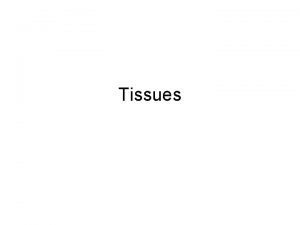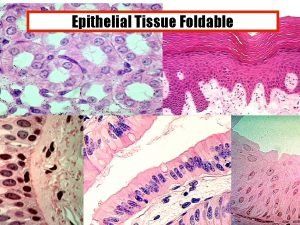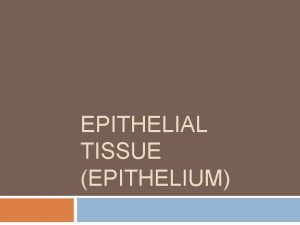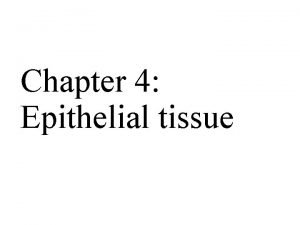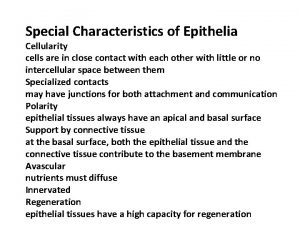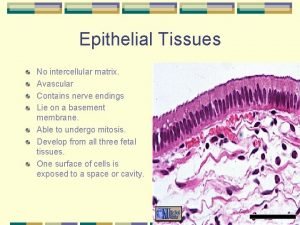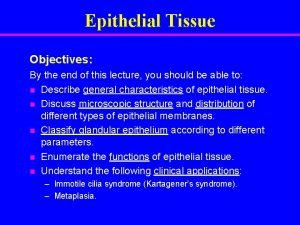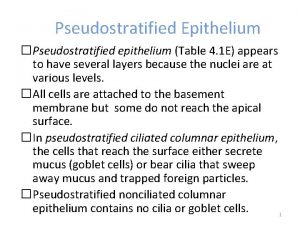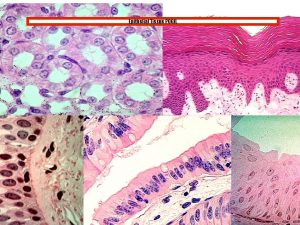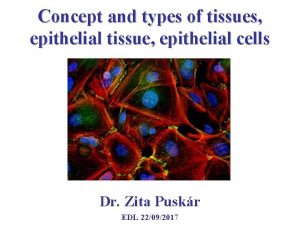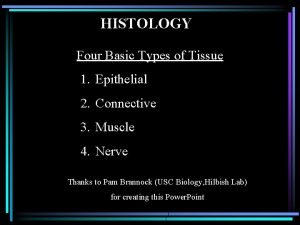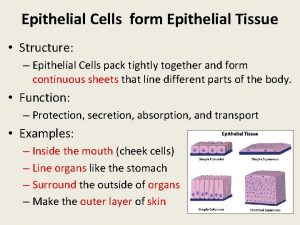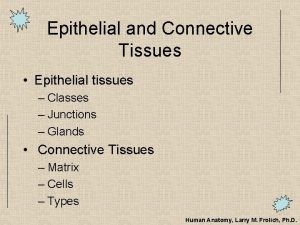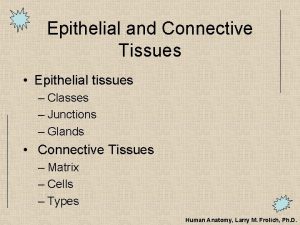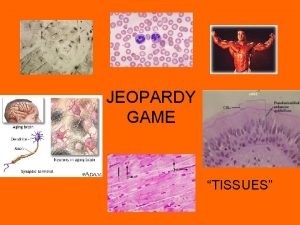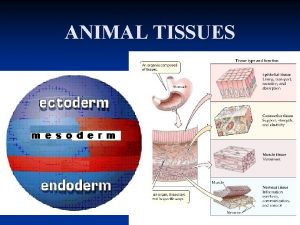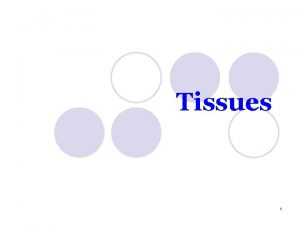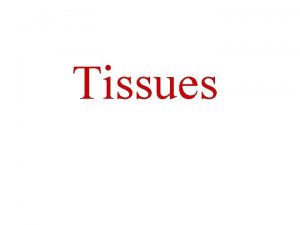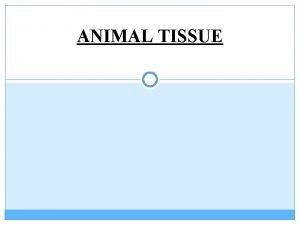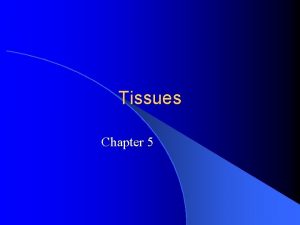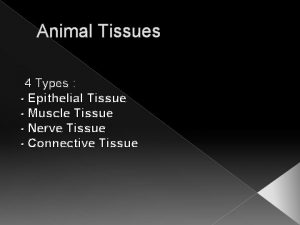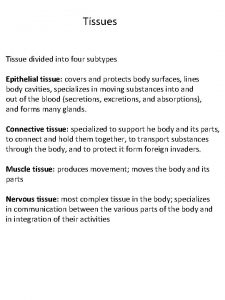Epithelial Tissue Cells and Tissues Cells are the
























- Slides: 24

Epithelial Tissue

Cells and Tissues · Cells are the building blocks of all living things · Tissues are groups of cells that are similar in structure and function – protection, absorption, secretion, movement, electrical impulses, etc.

Tissues • Four types of tissue – Epithelial = covering – Connective = support – Muscle = movement – Nervous = control • Most organs contain all 4 types • Connective tissue has non-living extracellular material (matrix) between its cells

• Epithelial – Covers body surfaces – Lines body cavities – Lines hollow organs – Ducts – Forms glands Tissues

Tissues • Connective – Protection and support – Binds organs together – Stores energy – bone marrow – Immunity

Tissues • Muscle – Movement

Tissues • Nerve – Detects change – Nerve impulses – Homeostasis

Epithelial Tissue • Tightly packed cells • Cell Junctions – form continuous sheets held together by cell junctions. – Tight junctions – Nothing passes through • Surfaces – apical, lateral and basal

Apical surface Basal surface 40 m Basal lamina Polarity of epithelia

Epithelial Tissues · Found in different areas · Body coverings · Body linings · Glandular tissue · Functions · Protection – Skin, lining of internal organs · Absorption – intestines · Filtration – Kidney · Secretion – Hormones, mucus, sweat, etc.

1. Epithelial Tissue Stratified squamous epithelium Cuboidal epithelium Simple columnar epithelium Simple squamous epithelium Pseudostratified columnar epithelium

Epithelial Tissues · Two types: 1. Covering and lining epithelium • • • Outer covering of skin, and internal organs Body cavities Blood vessels and ducts Interior of respiratory, digestive, urinary and reproductive organs Parts of sense organs 2. Glandular epithelium • Secreting portion of glands

Epithelium Characteristics · Cells fit closely together · Tissue layer always has one exposed surface (Apical surface) · The lower surface (basal surface) is bound by a basement membrane – Fibers · The side surface (lateral surface) is bound to other epithelial cells. · Avascular (have no blood supply) · Nerve supply · Regenerate easily if well nourished

Classification of Epithelium · Number of cell layers · Simple – one layer: diffusion (lungs), osmosis, filtration (kidneys), secretion (glands), absorption (intestines) · Stratified – more than one layer: protection, secretion Figure 3. 16 a

Classification of Epithelium · Shape of cells · Squamous – flattened · Cuboidal – cube-shaped · Columnar – column-like · Cilia 1. Nonciliated – absorptive cells (microvilli) and goblet cells (secrete mucus) 2. Ciliated – to move substances (Ex. Ovaries) Figure 3. 16 b

Simple Epithelia Human Anatomy, Larry M. Frolich, Ph. D.

Simple Epithelium · Simple squamous · Single layer of flat cells · Usually forms membranes · Lines body cavities · Lines lungs and capillaries Figure 3. 17 a

Simple Epithelium · Simple cuboidal · Single layer of cube-like cells · Common in glands and their ducts · Forms walls of kidney tubules · Covers the ovaries Figure 3. 17 b

Simple Epithelium · Simple columnar · Single layer of tall cells · Often includes goblet cells -produce mucus · Lines digestive tract – absorption of nutrients. Figure 3. 17 c

Stratified Epithelium · Stratified squamous · Cells at the free edge are flattened · Cells below can have other shapes · Found as a protective covering where friction is common · Locations · Skin · Mouth · Esophagus Figure 3. 17 e

Stratified Epithelium · Stratified squamous 1. Keratinized stratified squamous • Keratin deposit in apical layer and several layers below it. 2. Non-keratinized stratified squamous • No keratin Figure 3. 17 e

Stratified Epithelium · Stratified cuboidal – Rare · More than two layers of cuboidal cells · Protection, secretion, absorption · Stratified columnar – Rare · Surface cells are columnar, cells underneath vary in size and shape · Protection and secretion

Stratified Epithelium · Transitional epithelium · Elastic · Shape of cells depends upon the amount of stretching · As the cells stretch, they become flattened · Lines organs of the urinary system Figure 3. 17 f

Pseudostratified Columnar Epithelium · Not a true stratified tissue. · All cells are attached to the basement membrane but not all reach the apical surface. · When viewed from the side, it appears that they have several layers
 Body tissue
Body tissue The 4 tissues
The 4 tissues Body tissues chapter 3 cells and tissues
Body tissues chapter 3 cells and tissues Anatomy chapter 3 cells and tissues
Anatomy chapter 3 cells and tissues Eisonophil
Eisonophil Mikael ferm
Mikael ferm Basal and apical surface
Basal and apical surface Layers of epithelial tissue
Layers of epithelial tissue Transitional epithelium
Transitional epithelium Epitelio glandular holocrino
Epitelio glandular holocrino Simple squamous epithelium location
Simple squamous epithelium location Histology of epithelial tissue pogil activity
Histology of epithelial tissue pogil activity Epithelial tissue
Epithelial tissue Zonula occludens
Zonula occludens Renderforest
Renderforest Cellularity of epithelial tissue
Cellularity of epithelial tissue Avascular epithelium
Avascular epithelium Characteristics of epithelial tissue
Characteristics of epithelial tissue Histology smooth muscle
Histology smooth muscle Stratified columnar epithelium
Stratified columnar epithelium Simple squamous tissue
Simple squamous tissue Epithelial tissue
Epithelial tissue Voluntary muscles
Voluntary muscles Epithelial tissue
Epithelial tissue Animal tissue
Animal tissue







